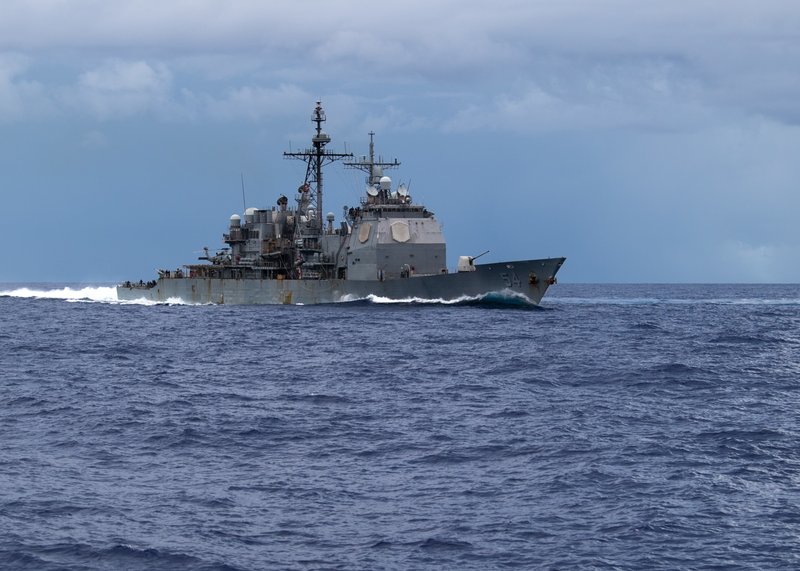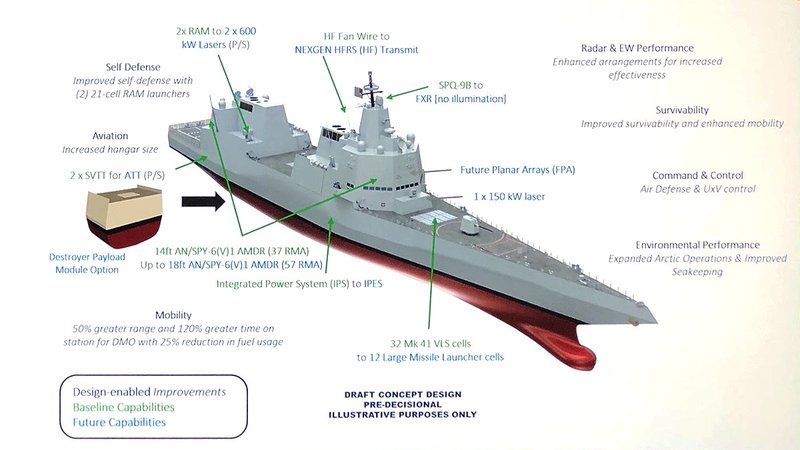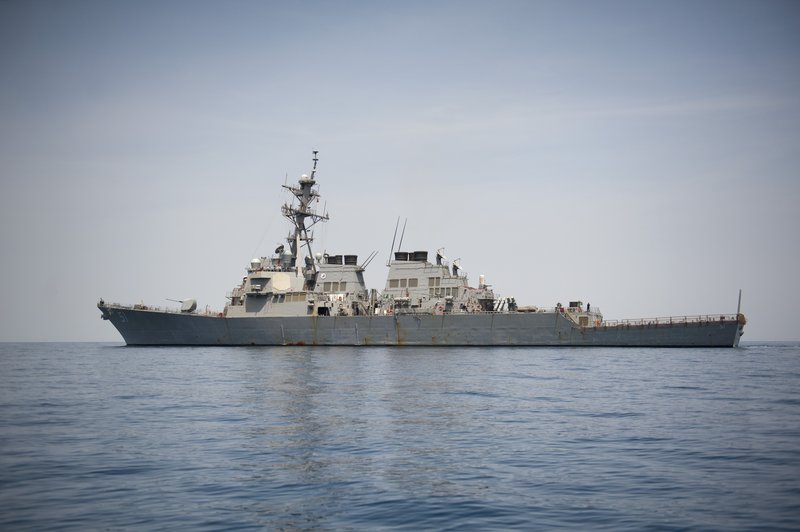Is the US Navy’s new DDG(X) destroyer facing cancellation?
An early artist's impression of what the USN's next-generation large surface combatant DDG(X) might look like. Much bigger than existing destroyers it will have the size, weight and power capacity to host future weapons, a larger munitions inventory and a longer endurance at sea. (Image: USN)
The USN’s next-generation Large Surface Combatant programme, known as DDG(X), is intended to replace the fleet’s ageing Ticonderoga-class (CG-47) cruisers and – eventually – all its Arleigh Burke-class (DDG-51) destroyers.
However, the outlook for the project remains grim. While is still in its early stages there are diverging cost estimates on the programme differing by up to $1 billion per ship. Meanwhile the navy is preoccupied dealing with an availability crisis with its submarine fleet and problems with its industrial base. A costly major surface combatant programme looming on the horizon is not what the USN needs on its books right now.
Mark Cancian, senior advisor with the International Security Program at the Center for Strategic and International Studies, told Shephard that earlier plans by the USN to replace the Ticonderoga class under the next-generation cruiser CG(X) programme “didn’t pan out” and the project was cancelled. He believes that DDG(X) could suffer the same fate.
“There are two problems that I think they are going to have, which are similar to CG(X). The first is pure cost; this is a big ship and it is going to be very expensive,” Cancian said.
A Congressional Budget Office (CBO) report from October 2023 estimated an average procurement cost of $3.2-3.5 billion per ship, which is significantly higher than the USN’s estimate of $2.5 billion, and the current $2.2 billion price tag of each Arleigh Burke destroyer.
“The second problem is that surface combatants don’t have a very high priority in the navy, and especially outside the navy. The top priority is submarines.”
Cancian added: “The problem with all surface ships is that in a high-intensity conflict with China they are very vulnerable until that Chinese missile inventory declines. That is why the USN says it doesn’t need the Ticonderoga class, but then it makes it harder to argue for a DDG(X), so the navy is going to have a hard time actually bringing it to fruition.”

The USN plans to decommission its remaining 18 Ticonderoga-class cruisers by FY2027 (Photo: USN)
The size of the DDG(X) is expected to be in excess of 13,500t – a big ship that will come with a huge price tag. This is a significant increase on the existing DDG-51 destroyers, with the latest Flight III variant coming in at over 9,700t and the cruisers at 9,800t.
“The USN are trying to get a hull and machinery that has the space to generate more power, looking ahead to laser-based systems. The hull form for the DDG-51 is at its maximum and the navy feels there is not enough room for expansion,” Cancian explained.
The extra space and weight capacity can be used to host additional electricity generation and cooling systems for high-powered directed-energy weapons as well as other new capabilities incorporated through the life of the warship.
But this means technological risk is also a factor. Laser armament for warships has yet to be proven even though there are strong arguments for its use, particularly for defence against swarming drones where it will not be possible to use SM-6 missiles to engage all targets.
“You have to prove out the system. You can’t build a ship and hope you have a laser to put on it, you have to figure out the laser requirements and see if it will work on the ship. The power requirement is so great and we have never really put one on a ship aside from some experimental designs that have not been developed or adapted,” Cancian said.
He explained that until the USN has a laser system that is proven, it is a hard sell to call for retirement of the existing Ticonderoga class and replace it with a similarly large ship, unless DDG(X) has a new capability that no other ship in the fleet can offer.

The Zumwalt-class destroyer was an expensive experiment in designing a land attack vessel. (Photo: USN)
Technological maturity of new concepts was one of the problems faced by the Zumwalt-class (DDG-1000) destroyer programme. Only three (of a planned 32) were built before the project was truncated. The technology risk impacted the vessel design, Integrated Power System (IPS), radar and weapons.
“If the project fails, and I think there is a high probability of that, then I hope it goes the way of the CG(X) rather than the Zumwalt. At least the CG(X) project was killed early on and the navy hadn’t invested a lot of money in them,” Cancian said.
The three Zumwalt-class destroyers cost $7.5 billion per ship totalling some $22 billion, including R&D. When the project was cancelled the navy opted to build the Flight III Arleigh Burke-class instead and continue with development of a mature design that had a hot production line. The navy now plans to re-role the Zumwalts to host hypersonic missiles.
“I think it is going to be hard to bring DDG(X) into existence given the cost and the lower priority,” Cancian said. “The navy needs to think hard about this and if they cancel it, they should do it early on. And I think they are going to have to do that, frankly.”
However, under existing plans, the USN wants to starting procuring the first DDG(X) in FY2032. This represents a delay to the original planned date of FY2028. Initial R&D funding of $187.4 million has been allocated to the project in the FY2024 budget with an additional request for $102.8 million for FY2025.
Meanwhile in February 2024, the DoD awarded DDG(X) designers Gibbs & Cox a $36.7 million option for continuing design and engineering efforts following an initial contract in 2022. This indicates that the USN seems determined to progress with DDG(X). Bath Iron Works and HII have also secured advanced design support contracts.

The preliminary concept design from USN project office PEO Ships highlighting DDG(X) capabilities. (Image: USN)
A GAO report from October 2023 highlighted planned purchases of between 30 and 46 DDG(X) destroyers that will form almost half of the large surface combatant fleet of 73-85 vessels in the 2053 timeframe. The CBO stated that the middle option of procuring 38 ships would cost $130 billion compared to the USN estimate of $93 billion from 2024-2053.
So using a ship of this size to eventually replace the entire Arleigh Burke class (currently at 73 ships) is unrealistic. Defence procurement projects are rarely delivered to budget, so it is likely even these estimates are conservative. It will eventually simply become too expensive.
According to the GAO the USN has argued that the technology risk faced by the Zumwalts would not be the same with DDG(X) because it would be using the existing Aegis combat system and AN/SPY-6 radar found aboard DDG-51 Flight III ships. Only a new hull, power and cooling systems are needed. But the IPS was one of the main technological challenges on the DDG-1000.
The main subsystems aboard DDG(X) are 96 Vertical Launch System cells but with extra capabilities to launch larger longer-range missiles, a Destroyer Payload Module for additional mission equipment and the IPS. It will also feature greater endurance, requiring reduced logistics support.
“But when the USN thinks about future needs, the two things they really want a lot more of are submarines and uncrewed systems. They haven’t really settled on what exactly those uncrewed systems are but when you look at fleet architectures it is these and not surface combatants,” Cancian said. “They are just not a priority list and they are going to have a hard time sustaining its size as it is, without adding an expensive surface combatant like DDG(X).”

The USS Arleigh Burke was the first in a long-line of destroyers, which will be expected to last well into the 2060s with the new Flight IIIs potentially operating alongside the DDG(X) class, if the latter makes it to production. (Photo: USN)
Cancian expects that the DDG(X) project will continue for a few years as an R&D effort and then eventually stop before its progresses into any significantly costly procurement phase.
The USN is not the only DoD service making tough choices. For example the US Army has cancelled its Future Attack Reconnaissance Aircraft and the USAF has also had flagship projects terminated in the past and has more difficult decisions ahead.
“It depends on the growth of the budget and how much the USN gets,” Cancian said, “If there is extra money the USN could keep DDG(X) going – however the top line is very uncertain at this stage and this will affect all programmes, especially ones like these in early stages.”
He added: “But when they start spending real money and it shows up in the five-year programme with very high costs, that’s when the services really make these tough choices. Unfortunately sometimes they wait too long and that results in the three Zumwalt-class destroyers or three Seawolf-class submarines.”
Related Programmes in Defence Insight
Next-Generation Large Surface Combatants (LSC) - DDG(X) [USN]
Arleigh Burke Flight III (DDG 155 - DDG 159) [USN]
Related Equipment in Defence Insight
More from Naval Warfare
-
![RTX Raytheon advances with the development of new Barracuda mine neutraliser]()
RTX Raytheon advances with the development of new Barracuda mine neutraliser
The new Barracuda version has been engineered to perform enhanced subsea and seabed warfare missions.
-
![Future of the US Navy’s Arleigh Burke programme remains unclear]()
Future of the US Navy’s Arleigh Burke programme remains unclear
The US Navy does not have a precise date for the award of the procurement contract for the third Arleigh Burke-class destroyer despite having the funds to advance with the programme in FY2025.
-
![US Navy may look to foreign suppliers to accelerate shipbuilding programmes]()
US Navy may look to foreign suppliers to accelerate shipbuilding programmes
The US Navy (USN) is currently reassessing its acquisition efforts and seeking ways to reduce the multiple delays across the shipbuilding initiatives.






















